MULTIPLE CHOICE. Choose the one alternative that best completes the statement or answers the question.
1) Capital accumulation definitely
A) shifts the production possibilities frontier inward.
B) shifts the production possibilities frontier outward.
C) has no impact on the production possibilities frontier.
D) makes the production possibilities frontier steeper.
Answer: B
Explanation: A)
2) Moving from one point on the production possibilities frontier to another
A) involves an opportunity cost but no tradeoff.
B) involves a tradeoff and incurs an opportunity cost.
C) involves a tradeoff but does not incur an opportunity cost.
D) involves no tradeoff but it does incur an opportunity cost.
Answer: B
Explanation: A) B)
3) The principle of decreasing marginal benefit implies that the
A) additional benefit from obtaining one more of a good or service decreases as more is consumed.
B) total benefit from obtaining more of a good or service decreases as more is consumed.
C) total benefit from obtaining more of a good or service remains the same as more is consumed.
D) additional benefit from obtaining one more of a good or service increases as more is consumed.
Answer: A
Explanation: A) B) C) D)
4) An increase in the production of capital goods
A) shifts the production possibilities frontier outward in the future.
B) must increase the current production of consumer goods.
C) must decrease the future production of consumer goods.
D) shifts the production possibilities frontier inward in the future.
Answer: A
Explanation: A) B) C) D)
1)
2)
3)
4)
5) Economic growth can be represented by 5)
A) a movement down the production possibilities frontier (PPF).
B) an inward shift of the production possibilities frontier (PPF).
C) a movement up the production possibilities frontier (PPF).
D) an outward shift of the production possibilities frontier (PPF).
Answer: D
Explanation: A) B) C) D)
6) The production possibilities frontier itself illustrates 6)
A) all goods that can be produced by an economy.
B) all possible production of capital goods.
C) all goods and services that are desired but cannot be produced due to scarce resources.
D) the combination of goods and services that can be produced efficiently.
Answer: D
Explanation: A) B) C) D)
7) A marginal cost curve 7)
A) is upward sloping.
B) shows that as more of a good is produced, opportunity costs of producing another unit increase.
C) is bowed inward so that its slope can become negative.
D) Both answers A and B are correct.
Answer: D
Explanation: A) B) C) D)
8) According to the figure above, the opportunity cost of producing another computer is
A) higher at A
B) higher at B
C) the same at every point along the frontier.
D) different at most points along the frontier but equal at points A and B because they are equally distant from the axes.
Answer: B
Explanation: A) B) C) D)
9) When the production possibilities frontier is bowed outwards, the opportunity cost of producing more of one good
A) decreases in terms of the amount forgone of the other good.
B) remains constant.
C) increases in terms of the amount forgone of the other good.
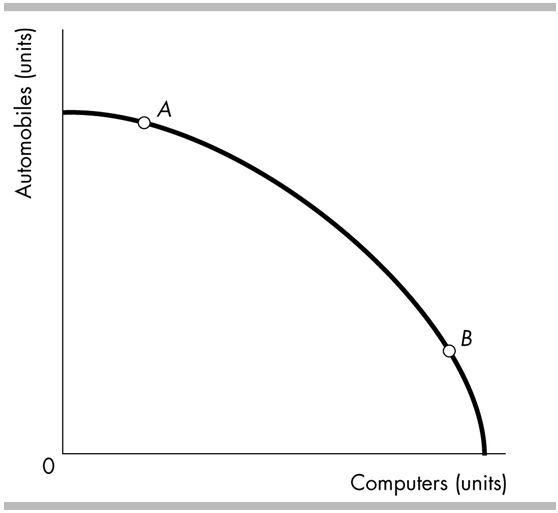
D) cannot be determined.
Answer: C
Explanation: A) B) C) D)
10) Markets
A) allow traders to enjoy gains from trade.
B) coordinate price information between buyers and sellers.
C) facilitate trade.
D) All of the above answers are correct.
Answer: D
Explanation: A) B) C) D)
8)
9)
10)
11) The above table shows production points on Sweet-Tooth Land's production possibilities frontier. What is the opportunity cost of one can of cola if Sweet-tooth Land moves from point C to point B?
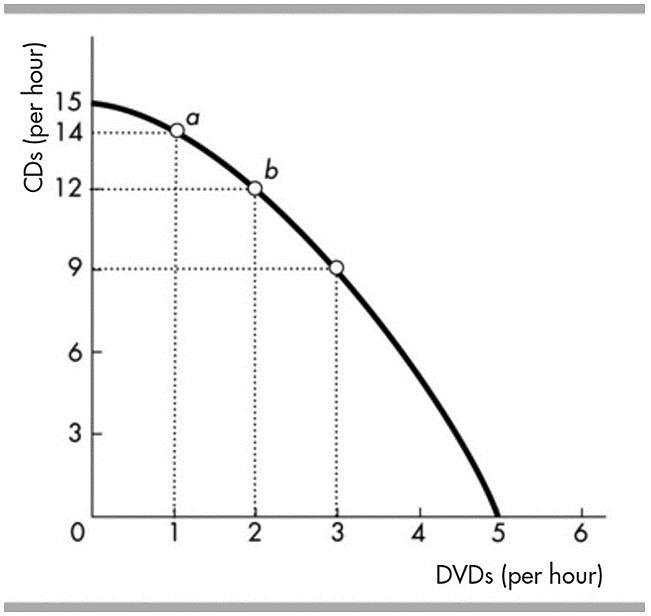
A) 10 chocolate bars per can of cola
C) 2 chocolate bars per can of cola
Answer: B
Explanation: A)
B) 1/2 chocolate bar per can of cola
D) 20 chocolate bars per can of cola
11)
12) In the above figure, at point a, what is the opportunity cost of producing one more CD?
A) 2 DVDs.
C) 14 DVDs.
Answer: B
Explanation: A) B) C) D)
B) 1 DVD.
D) There is no opportunity cost.
12)
13) In the figure above, the marginal cost of the second computer is
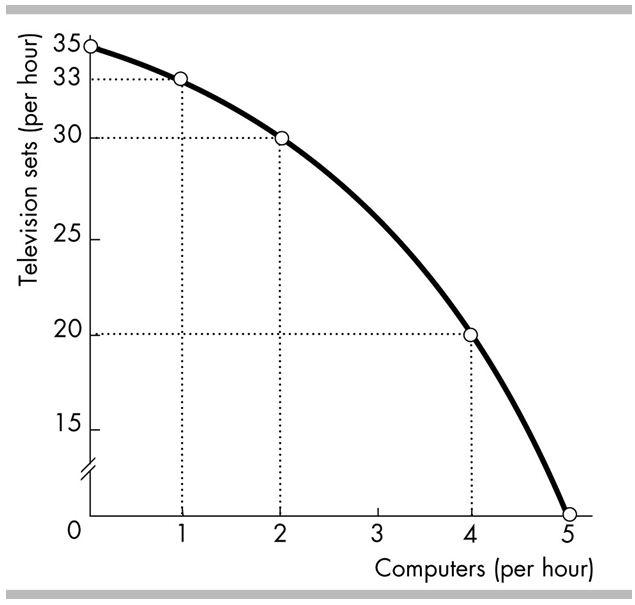
A) 2 television sets.
C) 5 television sets.
Answer: D
Explanation: A) B) C) D)
B) 30 television sets.
D) 3 television sets.
13)
14) In the figure above, both Joe and Jill initially produce at point A. If Joe and Jill realise that they each possess a comparative advantage, which outcome can we expect?

A) Joe will specialise in shirts and Jill will specialise in pants.
B) Joe will specialise in pants and Jill will specialise in shirts.
C) Joe and Jill each will be able to consume more than 2 shirts and 2 pairs of pants.
D) Both answers B and C are correct.
Answer: D
Explanation:
15) One of the opportunity costs of economic growth is
A) reduced current consumption.
C) the gain in future consumption.
Answer: A
Explanation: A) B) C) D)
14)
15)
B) technological change.
D) capital accumulation.
16) A person who has an absolute advantage in the production of all goods will
A) have a production possibilities frontier with a constant slope.
B) have a comparative advantage in the production of some goods but not in the production of others.
C) also have a comparative advantage in the production of all goods.
D) not be able to gain from specialisation and exchange.
Answer: B
Explanation: A) B) C) D)
16)
17) Scarcity is represented on a production possibilities frontier figure by 17)
A) the amount of the good on the horizontal axis forgone.
B) technological progress.
C) the fact that there are only two goods in the diagram.
D) the fact that there are attainable and unattainable points. Answer:
18) The table above shows the marginal benefit from pizza and the marginal cost of pizza in cans of cola forgone. If ________ pizzas are produced, the quantity of cola that people are willing to give up to get an additional pizza is more than the quantity of cola that they must give up to get that additional pizza.
A) more than 40
C) fewer than 40
Answer: C
Explanation:
18)
B) any quantity other than 40
D) 40
19) The opportunity cost of producing a unit of consumption goods at point b in the figure ________ point a.
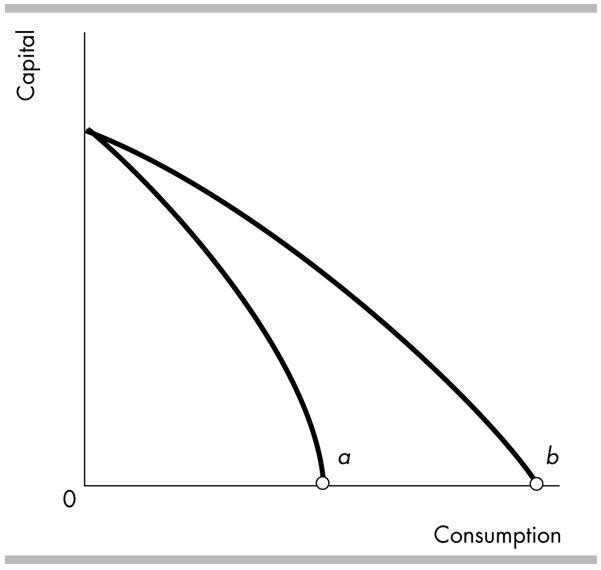
A) is greater than at
C) is less than at
Answer: C
Explanation:
B) is the same as
D) cannot be compared with
19)
20) In the above figure, in order for this country to move from production possibilities frontier PPF1 to PPF2, it might 20)
A) engage in exchange with other nations.
B) increase the average level of prices for all goods produced and consumed.

C) increase the skills and productivity of its work force.
D) put all unemployed resources to work producing desired output.
Answer: C
Explanation: A)
21) Which of the following statements regarding the production possibilities frontier is true? 21)
A) Points inside the frontier are attainable.
B) Points outside the frontier are attainable.
C) Points on the frontier are less efficient than points inside the frontier.
D) None of the above because all of the above statements are false.
Answer: A
Explanation:
22) The above table shows production points on Sweet-Tooth Land's production possibilities frontier. Which of the following is an example of a point that is inefficient?
A) 0 chocolate bars and 100 cans of cola
C) 20 chocolate bars and 80 cans of cola
Answer: B
Explanation: A)
B) 38 chocolate bars and 0 cans of cola
D) 32 chocolate bars and 40 cans of cola
22)
23) In the above figure, when 2000 bicycles are produced each month, we can see that
A) the marginal benefit from another bicycle is greater than the marginal cost of another bicycle.
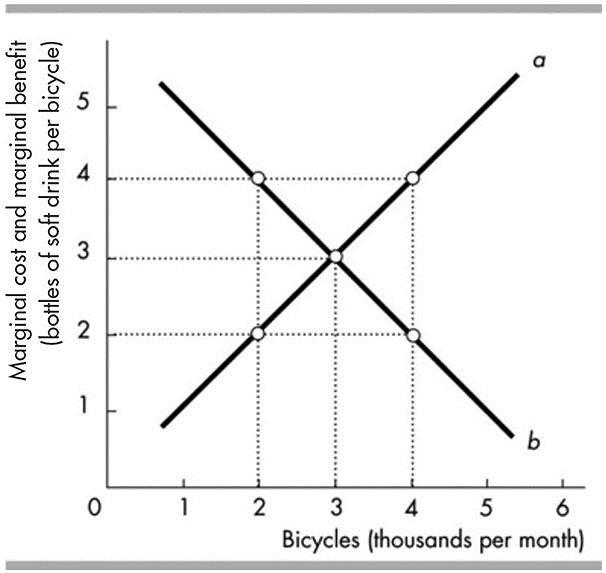
B) more bicycles should be produced to reach the allocatively efficient level of output.
C) the economy is very efficient at the production of bicycles because the marginal benefit exceeds the marginal cost.
D) Both answers A and B are correct.
Answer: D
Explanation: A) B) C) D)
23)
24) Betty and Ann live on a desert island. With a day's labour, Ann can produce 8 fish or 4 coconuts; Betty can produce 6 fish or 2 coconuts. Ann's opportunity cost of producing 1 coconut is ________ and she should specialise in the production of ________.
A) 0 fish per coconut; coconuts
C) 8 fish per coconut; fish
Answer: D
Explanation: A)
B) 6 fish per coconut; coconuts
D) 2 fish per coconut; coconuts
25) A PPF bows outward because 25)
A) not all resources are equally productive in all activities.
B) resources are used inefficiently.
C) entrepreneurial talent is more abundant than human capital.
D) consumers prefer about equal amounts of the different goods.
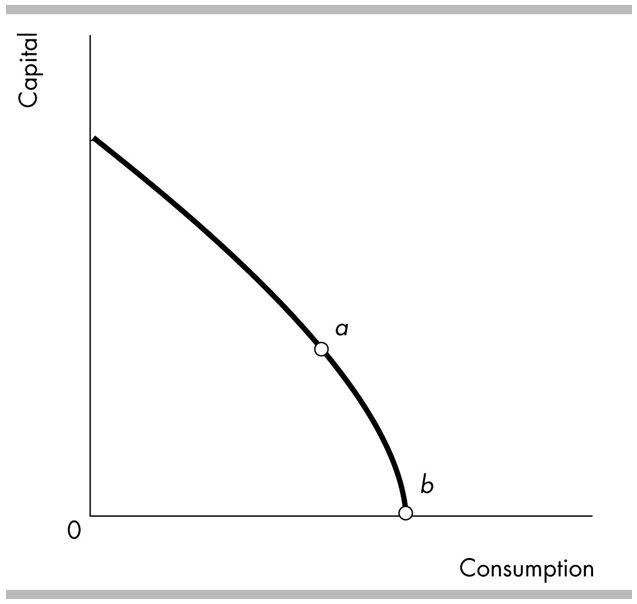
Answer: A
Explanation: A)
26) Two countries, Alpha and Beta, have identical production possibilities frontiers. If Alpha produces at point a and Beta produces at point b, then 26)
A) Alpha's and Beta's economic growth rates will be the same.
B) Beta's economic growth rate will exceed Alpha's.
C) Beta's future consumption will be greater than Alpha's.
D) Alpha consumes less than Beta today, but it will grow faster than Beta.
Answer: D
Explanation: A) B) C) D)
27) The bowed outward shape of the production possibilities frontier in the above figure indicates that 27)

A) computer technology is subject to the principle of decreasing costs.
B) some resources are better suited for producing computers.
C) the opportunity cost of producing more computers decreases as more computers are produced.
D) All of the above answers are correct. Answer: B Explanation:
28) In the table above, country B is producing 4 units of X and 6 units of Y. For country B, the opportunity cost of producing an additional unit of X is 28)
A) 3/2 units of Y per unit of X
C) 4 units of Y per unit of X
Answer: A
Explanation: A) B) C) D)
B) 1 unit of Y per unit of X
D) 2 units of Y per unit of X
29) If an economy is operating at a point inside the production possibilities frontier, then
A) the PPF curve will shift inward.
B) society's resources are being inefficiently utilised.
C) economic policy must retard further growth of the economy.
D) society's resources are being used to produce too many consumer goods.
Answer: B
Explanation: A)
30) Some time ago the government of China required many highly skilled technicians and scientists to engage in unskilled agricultural labour in order to develop "proper social attitudes." This policy probably caused China to produce
A) inside its production possibilities frontier with respect to food, but outside with respect to high-technology goods.
B) inside its production possibilities frontier.
C) outside its production possibilities frontier with respect to food, but inside with respect to high-technology goods.
D) at an inappropriate point along its production possibilities frontier.
Answer: B
Explanation: A)
30)
31) Resource use is allocatively efficient when 31)
A) we produce the amount of the different goods we value most highly.
B) we produce the goods with the lowest opportunity cost.
C) we cannot produce more goods and services.
D) we produce the goods with the highest opportunity cost.
Answer: A
Explanation: A)
32) A tradeoff is
A) a transaction at a price either above or below the equilibrium price.
B) a constraint that requires giving up one thing to get another.
C) represented by a point outside a PPF
D) represented by a point inside a PPF
Answer: B
Explanation: A) B) C) D)
32)
33) A person has a comparative advantage in producing a particular good if that person
A) has higher productivity in producing it than anyone else has.
B) has less desire to consume that good than anyone else has.
C) can produce it at lower opportunity cost than anyone else can.
D) has more human capital related to that good than anyone else has.
Answer: C
Explanation: A) B) C) D)
34) Suppose Joe can prepare 20 sandwiches or 10 pizzas in an hour and Beth can produce 36 sandwiches or 27 pizzas. The concept of comparative advantage concludes that
A) Beth should produce both goods because she can produce more of both goods in an hour than can Joe.
B) Beth should produce both goods and Joe should produce sandwiches.
C) Beth should produce sandwiches and Joe should produce pizza.
D) Beth should produce pizza and Joe should produce sandwiches.
Answer: D
Explanation:
35) Suppose a scientific breakthrough made free solar power available in unlimited quantities in Australia. The effect of this invention would be to move
A) the Australian production possibilities frontier outward.
B) Australia beyond its production possibilities frontier.
C) Australia inside its production possibilities frontier.
D) the Australian production possibilities frontier inward.
Answer: A
Explanation: A) B) C) D)
36) In the above figure, which of the following is true regarding the movements from point A to B and from point C to D?
I. The movement from point A to B shows that the economy has chosen to produce 100 more jets.
II. The movement from point C to D shows that the economy has chosen to produce 100 more jets.
III. The movements from point A to B and from point C to D have the same opportunity cost.
A) I and II
Answer: A
Explanation:
B) I and III
C) II and III
D) I, II and III
36)
37) Based on the above table, as the production of pizza increases, the opportunity cost of pizza in terms of forgone cases of cola
A) increases.
C) decreases.
Answer: A
Explanation: A) B) C) D)
B) initially increases then decreases.
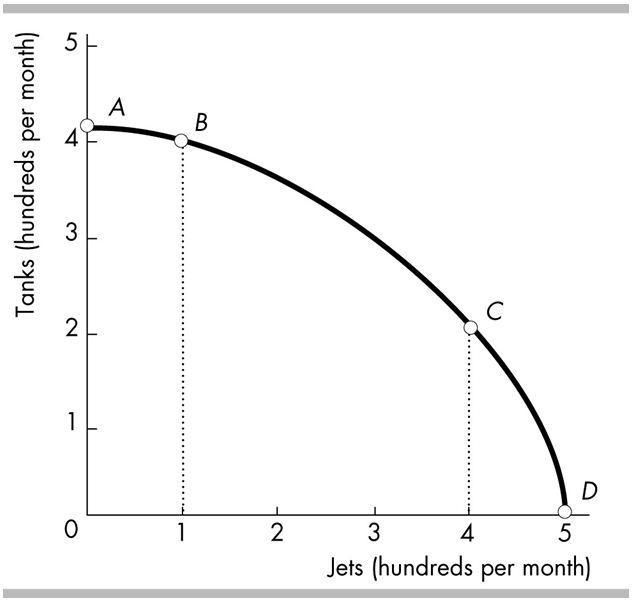
D) does not change.
37)
38) Refer to the production possibilities frontier in the figure above. Which production point is unattainable? 38)
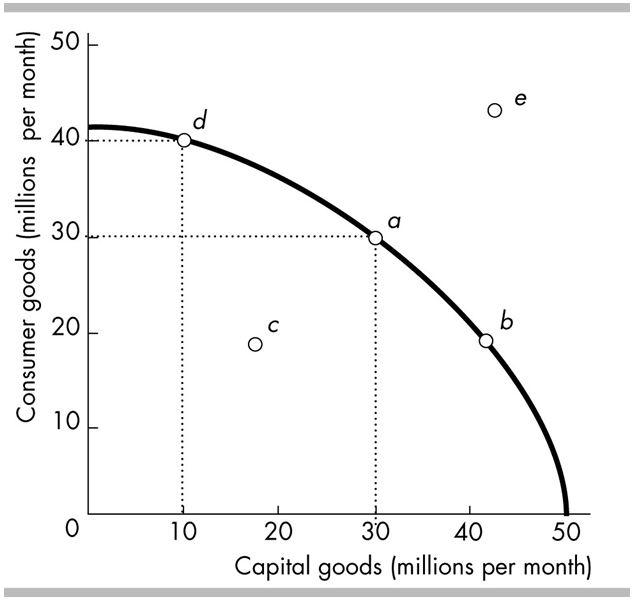
A) Point a B) Point b C) Point c D) Point e
Answer: D
Explanation: A) B) C) D)
39) In the above figure, once on PPF2, a country would grow slowest by producing at point 39)
A) C B) B C) D D) A
Answer: C
Explanation: A) B) C) D)
40) In goods markets ________ and in factor markets ________.
A) firms sell to households; households sell to firms
B) households sell to firms; firms sell to households

C) households sell to firms; households sell to firms
D) firms sell to households; firms sell to households
Answer: A
Explanation: A) B) C) D)
41) Homer and Teddy are stranded on a desert island. To feed themselves each day they can either catch fish or pick fruit. In a day, Teddy could pick 60 pieces of fruit or catch 20 fish. Homer could pick 100 pieces of fruit or catch 150 fish. Which of the following statements is correct?
A) Homer has an absolute advantage in picking fruit and Teddy has an absolute advantage in catching fish.
B) Teddy has an absolute advantage in both catching fish and picking fruit.
C) Homer has an absolute advantage in catching fish and Teddy has an absolute advantage in picking fruit.
D) Homer has an absolute advantage in both catching fish and picking fruit.
Answer: D
Explanation: A) B) C) D)
41)
42) Production efficiency occurs when production
A) is on the production possibilities frontier.
B) is on the production possibilities frontier or inside it.
C) is at any attainable point.
D) is at a point beyond the production possibilities frontier.
Answer: A
Explanation: A)
43) When resources are assigned to inappropriate tasks, the result will be producing at a point
A) outside the PPF
C) inside the PPF
Answer: C
Explanation: A)
B) where the slope of the PPF is zero.
D) where the slope of the PPF is positive.
44) In the above figure, curve b shows the
A) bottles of cola that people are willing to forgo to get another bicycle.
B) benefits of producing more bicycles is greater than the benefits of producing more cola.

C) bottles of cola that people must forgo to get another bicycle.
D) benefits of producing more cola is greater than the benefits of producing more bicycles.
Answer: A
Explanation: A) B) C) D)
45) According to the principle of comparative advantage, if a rich country trades with a poor country, then 45)
A) the rich country will lose and the poor country will benefit.
B) the rich country will benefit and the poor country will lose.
C) both countries will benefit.
D) neither of the countries will benefit.
Answer: C
Explanation: A) B) C) D)
46) In the figure above, the marginal cost of producing a computer 46)

A) is the same as the marginal cost of producing a television set.
B) stays the same as more computers are produced.
C) increases as more computers are produced.
D) decreases as more computers are produced.
Answer: C
Explanation: A) B) C) D)
47) A nation's production possibilities frontier is bowed outward. Suppose that the government decides to increase the production of armaments by $20 billion, and that as a result the output of consumer goods falls by $20 billion. If a further $20 billion increase beyond the initial $20 billion increase in armaments output is sought, we can expect that the output of consumer goods and services will fall further by
A) less than $20 billion.
B) more than $20 billion.
C) $20 billion.
D) There is not enough information to determine the answer.
Answer: B
Explanation:
48) If property rights are not clearly defined and enforced, then
A) resources are devoted to protecting possessions rather than to production.
B) incentives for specialisation based on comparative advantage are weakened.
C) some potential gains from specialisation and trade are lost.
D) All of the above answers are correct.
Answer: D
Explanation: A) B)
